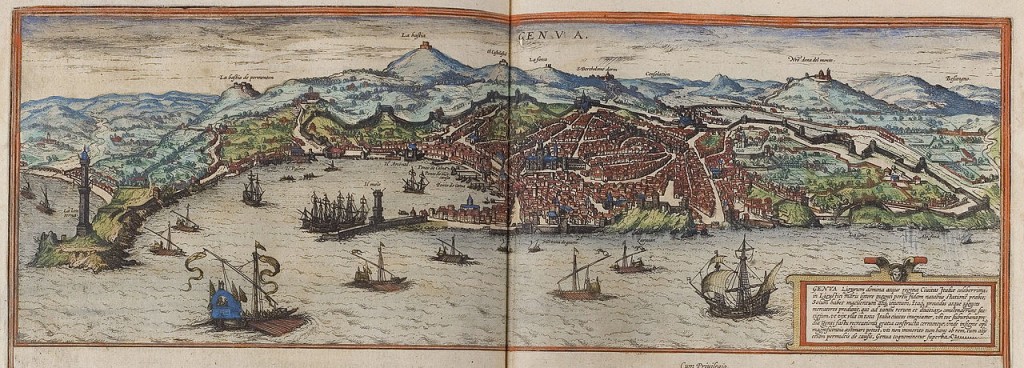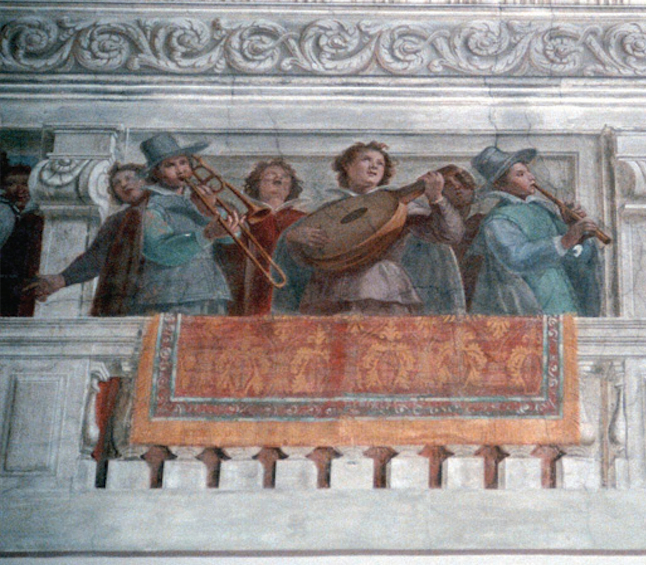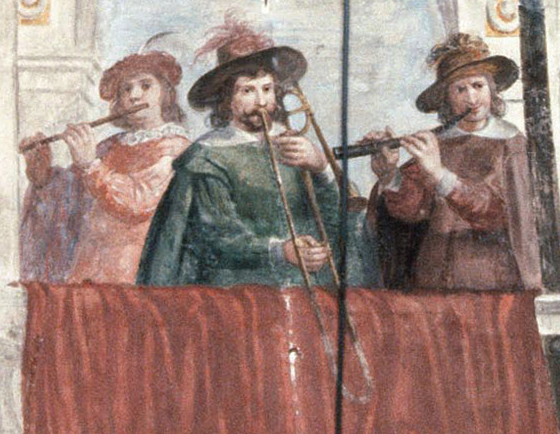 Earlier today I added the three trombone images below from Genoa to the Trombone History Timeline. They come from an excellent article by Thomas Heck recently published in the journal Early Music. I have also added the other items on Genoa that are currently in the Timeline (while noticing that I still have several other Genoa-related items to add—but this is all for now).
Earlier today I added the three trombone images below from Genoa to the Trombone History Timeline. They come from an excellent article by Thomas Heck recently published in the journal Early Music. I have also added the other items on Genoa that are currently in the Timeline (while noticing that I still have several other Genoa-related items to add—but this is all for now).
I also added the images, where applicable, to a couple of specific collections of iconography: How to Hold a Sackbut: The Grip of the Early Trombone in Pictures and Angel Trombonists Throughout History.
________________________
1590—Genoa, Italy: A document on the duties and rights of the members of the Genoese wind band stipulates, among other things, “The musicians shall be seven or eight in number, with parts for trombones [tromboni] and parts for cornetts, that is, first and second trombone, first and second cornett, and the other three parts in the middle shall be given to trombones or to cornetts according to what is required” (Dickey, The Cornett 56).
c. 1624—Genoa, Italy: Giovanni Andrea Ansaldo’s trompe l’oeil balcony painting in the castle Villa Spinola di San Pietro includes a trombone among numerous other instruments playing from the balcony (see detail and full image below; click to expand; public domain) (Heck, Guitarists in the Balconies).
 c. 1630—Genoa, Italy: A trompe l’oeil balcony by Giovanni Bernardo Carlone and Giovanni Battista Carlone in the palace Villa Spinola alla Prioria di S. Agnese features a well-dressed trombone player among a small group of musicians (see detail and full image below; click to expand; public domain images) (Heck, Guitarists in the Balconies).
c. 1630—Genoa, Italy: A trompe l’oeil balcony by Giovanni Bernardo Carlone and Giovanni Battista Carlone in the palace Villa Spinola alla Prioria di S. Agnese features a well-dressed trombone player among a small group of musicians (see detail and full image below; click to expand; public domain images) (Heck, Guitarists in the Balconies).
 c. 1640—Genoa, Italy: A niche painting in Chiesa della SS. Annunziata includes an angel playing trombone (see below image; click to expand; public domain) (Heck, Guitarists in the Balconies).
c. 1640—Genoa, Italy: A niche painting in Chiesa della SS. Annunziata includes an angel playing trombone (see below image; click to expand; public domain) (Heck, Guitarists in the Balconies). 1681—Genoa, Italy: Alessandro Stradella composes Inventione per un barcheggio for the wedding celebrations of Signori Carlo Spinola and Paula Brignole, members of two noble families. In the work, trombone is specified as part of the continuo. Precise instructions include the following: “All the basses with one trombone, but the trombone must play very staccato and with little breath.” The performance, as described by a chronicler of the time, takes place on the water: “Towards the evening on Thursday the ladies and gentlemen of this city had a sumptuous diversion on the bay, having been taken round the harbour by four galleys, besides a very great number of smaller boats, and then conducted aboard an apparatus [made] of barges, [which] formed a hall covered by light-weight silk and richly adorned. Here they were entertained with an interweaving of harmonious voices, poetry and instrumental music accompanied by the most exquisite food and refreshments of all sorts…” (Gianturco).
1681—Genoa, Italy: Alessandro Stradella composes Inventione per un barcheggio for the wedding celebrations of Signori Carlo Spinola and Paula Brignole, members of two noble families. In the work, trombone is specified as part of the continuo. Precise instructions include the following: “All the basses with one trombone, but the trombone must play very staccato and with little breath.” The performance, as described by a chronicler of the time, takes place on the water: “Towards the evening on Thursday the ladies and gentlemen of this city had a sumptuous diversion on the bay, having been taken round the harbour by four galleys, besides a very great number of smaller boats, and then conducted aboard an apparatus [made] of barges, [which] formed a hall covered by light-weight silk and richly adorned. Here they were entertained with an interweaving of harmonious voices, poetry and instrumental music accompanied by the most exquisite food and refreshments of all sorts…” (Gianturco).